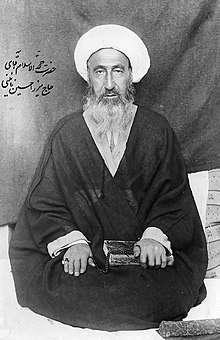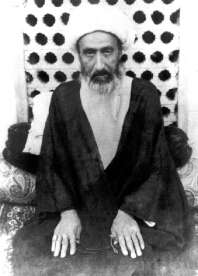Muhammad Hossein Naini
Grand Ayatollah Sheikh Muhammad-Hussein Naini Gharavi (Persian: محمد حسین نائینی غروی; May 25, 1860–August 14, 1936) was Iranian Shia marja'.
Grand Ayatollah Sheikh Muhammad-Husayn Naini | |
|---|---|
شيخ محمد حسين نائينى غروي | |
 | |
| Personal | |
| Born | May 25, 1860 |
| Died | August 14, 1936 (aged 76) Najaf, Iraq |
| Resting place | Imam Ali Shrine |
| Religion | Islam |
| Nationality | Iranian |
| Region | Najaf, Iraq |
| Jurisprudence | Twelver Shia Islam |
| Main interest(s) | Islamic philosophy, Usul al-fiqh |
| Notable work(s) | Dubios Habit Vassilat'un Nijat Ressalat la Zarar |
| Muslim leader | |
| Based in | Najaf, Iraq |
| Period in office | 1911–1936 |
| Predecessor | Akhund Khorasani |
| Successor | Abu l-Hasan al-Isfahani |
His father Mirza Abdol Rahim and grandfather Haji Mirza Saeed, both one were Sheikhs of Nain and Mohammad Hussein proved himself the most competent student of Ayatollah Kazem Khorasani. Ayatollah Naini is considered to be the most famous theoretician of Iran's Constitutional Revolution. He died in 1936 and was buried next to shrine of Imam Ali in Iraq. Among his works, notable references are his Dubios Habit, Vassilat'un Nijat, and Ressalat la Zarar. 50th death anniversary of Ayatollah Mirza Mohammed Hussein Naini was memorialized by issue of Stamps Tickets, in Iran, in 1987.[1]
Biography
Mirza Muhammad Hossein Naini was born to a respected and religious family of Nain on 25 May 1860 [2] ( 15 Dzulqadah 1276 Lunar Hijrah [3]). His father Mirza Abdol Rahim and grandfather Haji Mirza Saeed, both one after another were Sheikhs of Nain. Ayatollah Muhammad Hussein Naini, who is better known as Mirza Naini, did his primary studies in Nain and then in 1877 when he was 17 years old, moved to Isfahan. Here he lived with Haji Shaikh Muhammad Baqir Isfahani for seven years. The latter belonged to a distinguished clerical family of Isfahan and was himself the most powerful Mujtahid of that city.[4] After completing basic education he moved to Najaf, Iraq, to achieve the degree of Ijtihad. He proved himself the most competent student of Ayatollah Kazem Khorasani [5] Ayatollah Naini is considered to be the most famous theoretician of Iran's Constitutional Revolution.

Teaching and politics
Bridge between religion and modern science
Colonialists of last two centuries invented the theory of separation of politics from religion and rivalry between the old and the new sciences in order to create a gulf between these two systems. They not only divided the language of religion from language of modern science, culture and philosophy, but also developed a big difference between the two with the result that conciliation between these two languages becomes difficult. That is why whenever an anyone of those religious minded people who had been to Europe and were conversant with modern civilization and culture, tried to defend and transmit whatever of religion was left to him, he in most cases presented religion in an ambiguous form which materialized to be incompatible with modern civilization and modern sciences. Realizing the situation, many of scholars, especially during the last 100 years have tried to bridge this gulf and to introduce modern science and civilization in a perspective compatible with the broad and progressive outlook of Islam and free from all misconception and misrepresentation. Mirza Naini is considered to be the most influential authority by introducing his revolutionary approaches to combat the gap between religion and modernity. The integrity of his students in the religious and modern world is the criteria for constructive critic and appreciation.[6][7]
Pupils

Names of the some students benefited from the teaching of Mirza Naini, includes the following scholars and clerics of their time:
- 1. Sheikh Mohammad Ali Kazemi Khorassani
- 2. Seyyed Mohsen Tabatabai Hakim.[8]
- 3. Grand Ayotollah Khoei.[9]
- 4. Seyyed Mohammad Hossein Tabatabai
- 5. Grand Ayatollah Taqi Bahjat
- 6. Sayyed Hadi Milani
- 7. Sayyed Jamal Al din Golpayegani
- 8. Sheikh Muhammad Ali Kazemini
- 9. Sheikh Mousa Khansari[10]
Rationality claims merit not the relation
Among the modern Usuliyan Shia scholars Mirza Naini is regarded as one of the founders of modern principles of jurisprudence. Intellectual development in term of social progress of science can be observed between Mirza Naini and his reverenced Master Ayatollah Kazem Khorasani, which establishes the fact that difference of opinion is not the cause of hostilities the very basis of battle is ignorance. His master represents Sadrian Islamic thought. Defending principles of "Sadrian philosophy", with his full support to Sadrian view in the interpretation of causality and its relation to freedom. On the other side, his intelligent pupil (Mirza Naini) was one of the strong critics of Sadrian view. In a new way and method, he criticized the Sadrian philosophical thought and presented a new viewpoint on the relation between causality and human freedom.[11]
Naini as a politician
Ayatollah Naini was active both in Iran's Constitutional Revolution and in Iraqi Politics. As a politician his principal view with regard to form of government is very clear. He suggested the form of government by an infallible ruler fully responsible to the will of God, which might be able to safeguard the interests of people. Such type of ruling is not possible in the era of major occultation of Imam Mahdi. Therefore, efforts should be made to arrange the ruling of just and honest men with duty to control the government, directly responsible to the will of God through Imam Mahdi. He further argued that in such a situation it is the known fact that access to leaders with such respected characteristics’ becomes unquestionable and people usually have no say over such matters, it is thus obligatory to observe the following two principles:
- 1. To implement law
- 2. To appoint wise men as "supervisors"
Obviously these were the possible steps for removal of huge gap between the existing situation and the desired goals of forming progressive government for the betterment of people.[12][13]
Works
Mirza Naini being an expert on Usul al Fiqh was the first human being in the history of Iran to construe the idea of religious dictatorship. Naini stressed the concept of Aql (dialectic reasoning) and believed that Islam was compatible with progress. He also argued that the most intolerable form of autocracy is the tyranny imposed by a religious state. He had written a book Tanbih al-Ummah wa Tanzih Al-Milla (the awakening of the community and refinement of the nations) which was translated into Arabic by Salih Kashi al Gheta and published in 1909 by the Institute of Strategic Studies in Baghdad. His book mainly relates to theory of constitutional revolution with his deliberations on the major topics of “Ignorance and Despotism”. In his book, he discussed interalia, the view that freedom of the pen and speech both are God given freedom necessary for liberation from despotism (taghut). Elaborating his view and in replying to opponents of Constitutionalism he pointed out that Islamic Law has two distinct categories: the primary laws are based on the Quran and other known Islamic principles, were unchangeable. The secondary laws, in contrast, were subject to change, depending on temporal and spatial circumstances, making them the proper sphere for legislation.[14][15]
Exile
At [16] the beginning of World War-I, the Shiite Scholars and clerics of Iraq were not the supporter of allied powers, however, they entered the scene and declared holy war against the Central power. Consequently, Mirza Naini was exiled with Abul Hassan Isfahani to Iran. They were welcome and received by Abdul-Karim Ha'eri Yazdi, the then head of Feizieh religious school. However, after a short stay Naini was allowed for his return to Iraq with advice not to be involved in politics.
Death
Ayatollah Mirza Hussain Naini died in 1936 at the age of 76. He is buried in Najaf.

See also
- Iranian Constitutional Revolution
- Intellectual movements in Iran
- Mohammad-Kazem Khorasani
References
- http://colnect.com/en/stamps/stamp/463006-Mirza_Mohammed_Hossein_Naini_1860-1936-50th_death_of_Ayatollah_Mirza_Mohammed_Hossein_Naini-Iran retrieved: 2014-10-07
- http://www.geni.com/people/Mirza-Mohammad-Hosein-Naini-Gharawi/6000000013028128763 Retrieved: 2014-10-08
- "Birth of Ayatollah Mirza Hossein Naini". 2014-09-11. Retrieved 2014-10-06.
- Shi’ism and Constitutionalism in Iran ( A study of the Role played by the Persian Residents of Iraq in Iranian Politics) By Abdul Hadi Hairi - by E.J. Brill Leiden, Netherlands – 1977, Printed in Belgium ISBN 90 04 04900 2
- Comparative Study Thesis Umma Lalan and Tanbih Al Umma Mirza Naini, by Amir Pourzaman - Rahim Vakilzadeh, Journal of Political & Social Sciences. Vol., 1 (1), 1-5, 2014 (ISSN 2148-5127©2014) Available online at http://www.jpssjournal.com
- "Foreword to Ayatullah's Last Lectures". Dr. Sayyid Jamal Musavi. Retrieved 2014-10-07.
- "Causality and Freedom". By: Mohsen Araki. Archived from the original on 2014-10-13. Retrieved 2014-10-07.
- "Imam Abul Qasim al-Khoei". Arsalan Rizvi. 2008-08-24. Retrieved 2014-10-07.
- "Imam Abul Qasim al-Khoei". By: Arsalan Rizvi. 2008-11-16. Retrieved 2014-10-07.
- Interview with Hajj Mehdi Qaravi, Hawzeh Magazine, num:76-77, p.407. 1375 solar
- http://www.al-islam.org/al-tawhid/vol17-no2-spring-2003/causality-and-freedom-ayatullah-mohsen-araki/abstract Retrieved: 2014-10-08
- Book: Tanbih al-Ummah wa Tanzih al-Millah by Mirza Muhammad Husayn Naini
- Extracted from: "A Review of Imam Khumayni's Political Thought". By: Kazim Qadizadeh and Mahdi Chamanzar. Archived from the original on 2014-10-13. Retrieved 2014-10-07.
- "Wilayat al Faqih & Despotism". Ataollah Mohajerani. 2009-07-22. Retrieved 2014-10-06.
- p.70-71 God and Juggernaut by Farzin Vahdat, Syracuse University Press New York, 2002
- "Mohammad Hussein Naini". Tahereh Shokuhi. Retrieved 2014-10-06.
External links
| Wikimedia Commons has media related to Muhammad Hossein Naini. |